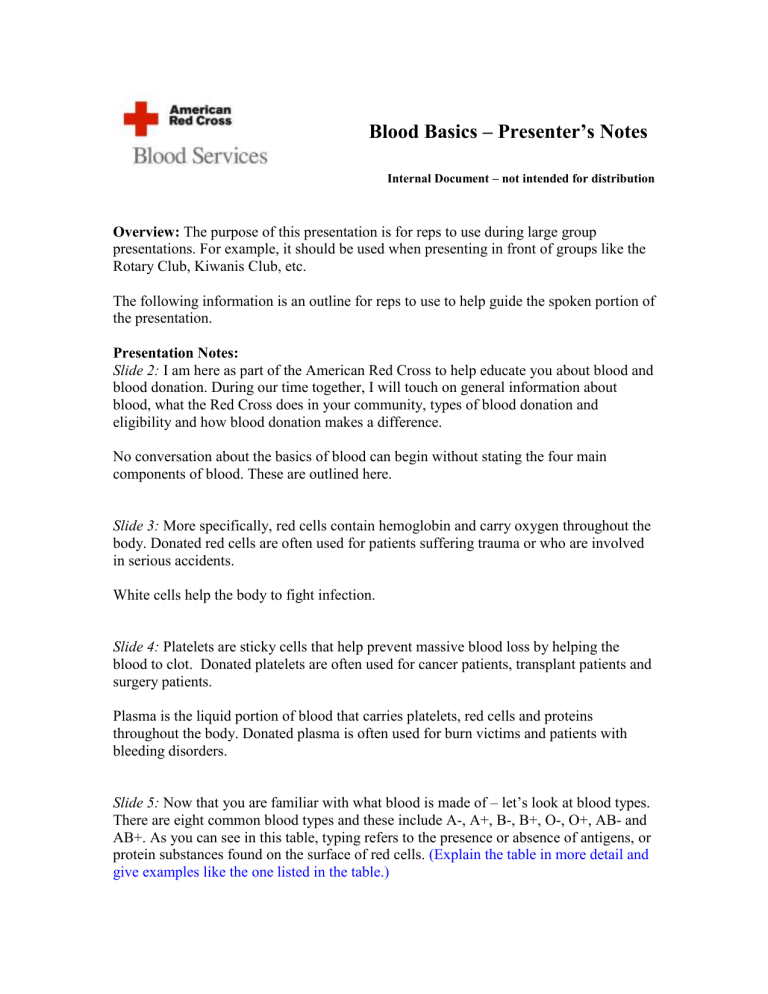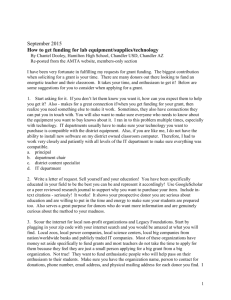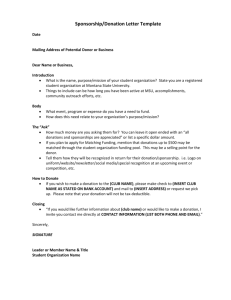Blood Basics Present..

Blood Basics – Presenter’s Notes
Internal Document – not intended for distribution
Overview: The purpose of this presentation is for reps to use during large group presentations. For example, it should be used when presenting in front of groups like the
Rotary Club, Kiwanis Club, etc.
The following information is an outline for reps to use to help guide the spoken portion of the presentation.
Presentation Notes:
Slide 2: I am here as part of the American Red Cross to help educate you about blood and blood donation. During our time together, I will touch on general information about blood, what the Red Cross does in your community, types of blood donation and eligibility and how blood donation makes a difference.
No conversation about the basics of blood can begin without stating the four main components of blood. These are outlined here.
Slide 3: More specifically, red cells contain hemoglobin and carry oxygen throughout the body. Donated red cells are often used for patients suffering trauma or who are involved in serious accidents.
White cells help the body to fight infection.
Slide 4: Platelets are sticky cells that help prevent massive blood loss by helping the blood to clot. Donated platelets are often used for cancer patients, transplant patients and surgery patients.
Plasma is the liquid portion of blood that carries platelets, red cells and proteins throughout the body. Donated plasma is often used for burn victims and patients with bleeding disorders.
Slide 5: Now that you are familiar with what blood is made of – let’s look at blood types.
There are eight common blood types and these include A-, A+, B-, B+, O-, O+, AB- and
AB+. As you can see in this table, typing refers to the presence or absence of antigens, or protein substances found on the surface of red cells. (Explain the table in more detail and give examples like the one listed in the table.)
Slide 6: Blood type is an inherited trait. Your blood type is determined by the blood types of your parents. The chart shown here illustrates the possibilities for children who have parents with certain blood type combinations. (Discuss examples from the table.)
Slide 7: (Read through the facts on this slide.) These facts prove that blood is a precious resource that we cannot live without. There is no substitute. With someone needing blood approximately every two seconds, the Red Cross is there to help, but we can’t do it alone.
We are in constant need of people to donate blood and sponsor blood drives.
Slide 8: Nationally, we supply more than 3,000 hospitals. Locally, we supply nearly 250 hospitals in 10 states.
Our national blood inventory management system enables us to provide blood to patients whenever and wherever they need it. More specifically, Blood Services regions are able to support each other when inclement weather, disasters and other conditions impact the ability to collect blood.
The rare donor registry allows donors with rare blood types the opportunity to further help patients with a very specific need.
Slide 9: Disaster relief is a 24-hour response focusing on meeting people’s immediate needs, which includes shelter, food, health and mental health services and enabling them to resume their normal daily activities independently. Every 8 minutes a disaster strikes, and these disasters can take shape as house or apartment fires, hurricanes, floods, earthquakes, tornadoes, hazardous material spills, transportation accidents, explosions and other natural and man-made disasters.
Each year, the Red Cross provides more than 600,000 services to U.S. service men and women, their families and veterans. For example, calls and messages are relayed every 22 seconds between Armed Forces Emergency Services centers, stations and chapters.
Emergency financial aid is also provided to service members, their families, retired military personnel and widows of retired military personnel.
Slide 10: The Red Cross trains 12 million people a year in skills such as CPR, first aid, water safety, babysitting and HIV/AIDS education.
International Services works with Red Cross, Red Crescent and equivalent societies.
Through international tracing, we work to locate loved ones who are separated or missing due to war, conflict or natural disaster. In addition, the Red Cross has a unique mandate to educate the American public about the International Humanitarian Law movement’s guiding principles and framework as it applies to the protection of members of the armed
forces. As for the malaria and measles initiatives - local education programs have been put in place to inspire individuals, organizations and corporations to take action to protect the lives of children and families from malaria in Africa. Also, each year, nearly 345,000 people around the world die from measles. It only takes $1 to pay for one vaccine and to save one child’s life. Disasters are happening around the world and many go unpublicized by the media. Although, we may not hear of all of these disasters as they happen, the needs of those affected are just as critical and important as those impacted by larger-scale disasters, such as the 2005 Southeast Asia Tsunami.
(The end of this slide is a good opportunity to discuss any existing Chapter relationships this organization may have – highlight how they can extend that relationship by partnering with Blood Services as well.)
Slide 11: Now that you are familiar with the basics of blood and the American Red Cross, let’s talk about types of blood donation and eligibility. During a whole blood donation, a pint is collected from a volunteer donor.
After donation, the whole blood unit is separated into components. Each component could potentially help three different people in three different situations.
Slide 12: The entire whole blood donation process from door to door lasts about 1 hour and 15 minutes. Actual time spent donating is just a few minutes.
After a whole blood donation, a donor cannot donate again for 56 days, which means a donor could donate whole blood up to 6 times in a year.
Like any other perishable item, red bloods cells do not last forever. For example, when we buy milk, it has a date by which to consume it. Red blood cells are similar in that they have a shelf life of 42 days. Further evidence of why constant blood donations are so important.
Slide 13: There are certain eligibility requirements donors must meet before they are able to donate. For whole blood, these requirements are shown here. (Read through donation requirements.) All requirements to donate are important because they ensure the safety of both donor and patient.
Slide 14: Automated platelet donations are another type of donation. During this process, the blood components are separated as the donor is donating, rather than in the lab after a whole blood donation. Special machines are used for this process that collected platelets and some plasma.
Slide 15: Platelet donations last a bit longer than whole blood donations. The entire process from door to door lasts about 1.5 to 2.5 hours.
Because platelets regenerate themselves quickly, donors can give more often – up to 24 times a year. We recommend apheresis donors give every 2 to 4 weeks.
Platelets have a much shorter shelf life than red cells as they last only 5 days.
Slide 16: The eligibility requirements for an automated platelet donation are as follows.
(Read through the requirements.) Note the extra requirement of no aspirin in the past 36 hours. This requirement is in place because aspirin tends to temporarily decrease platelet counts.
Slide 17: Automated double red cell donations are the last type of donation we will discuss. This is an automated process, much like apheresis donation. Instead of collecting platelets, a double unit of red cells is collected from donors.
Slide 18: Automated double red cell donations last a bit longer than a whole blood donation as well.
Donors are not able to donate for a longer period of time after an automated double red cell donation. Donor must wait 112 days before donating double red cells again.
Slide 19: The eligibility requirements for double red cell donations are shown here. (Read through the requirements.) Note the additional weight restrictions for men and women.
This is again to ensure safety of donor and patient.
Slide 20: While donors with all blood types can give through any type of blood donation described today, there are certain blood types that are better for certain types of donations. These situations are outlined in this table. For example, types O+ and O- are great blood types for double red cell donations and whole blood donations. This is because red cells from these types are in high demand. Type O- is the universal donor as this blood type can be transfused to anyone and type O+ is one of the most common blood types.
Slide 21: No matter what donation type a donor uses, the basic process for donating to the
Red Cross is the same.
When donors arrive at a donation site, the first step is to register by signing in and showing ID. Donors are then asked to read some important information about giving blood.
The next step is a mini-physical that includes checking vital signs and iron levels in a donor’s blood. There is also a health questionnaire that helps ensure that a donor’s blood is safe to give to patients in need. This interview will be private and confidential.
Depending on the answers, a donor may be deferred from donating, either temporarily or permanently.
On to the actual donation. We will cleanse an area of the arm a donor will be using to donate. All of the supplies, including the needle, are sterile and are used only once—for that donor. At the beginning a donor may feel a brief “sting” from the needle, but it doesn’t last long. A donor’s body will replace the plasma in hours and the blood cells in just a few days. After the donation, the donor will be given a form with post-donation instructions and a phone number to call if the donor decides after leaving that the unit of blood may not be safe to give to another person.
The refreshment area is the last step in the process. We encourage donors to take a few moments to relax with juice and snacks after donating.
Slide 22: The Red Cross continually updates and refines procedures to ensure its inventory is safe. Many patients and their families are concerned about the risk of contracting disease through a transfusion. Although blood transfusions are not risk-free, the blood supply is safer today than ever.
•
All Red Cross blood donors are carefully screened for risk factors that would disqualify them from giving blood.
• The Red Cross follows five layers of safety procedures for donated blood: selfdeferrals, completion of the blood donation record, health history screening, testing, and post-donation information.
• Multiple safeguards are built into the Red Cross’ collection, processing and distribution systems to protect both blood donors and transfusion recipients.
Slide 23: As you donate whole blood, your blood is collected in a pint-size bag and in six small test tubes. The needle used for your donation is sterile and is disposed of after your donation. Both the blood bag and the test tubes are sent to a Red Cross processing facility.
The Red Cross staff sends the test-tube blood samples to national testing laboratories.
The samples of your blood undergo tests to ensure that your blood is safe for patients.
While waiting for the test results, the Red Cross staff processes your blood donation. The blood components are held in quarantine until the test results are known.
When the test results are received and the blood declared safe for transfusion, the staff will label your blood components according to your blood type. The components are stored at the appropriate temperatures until they are distributed to hospitals. At the hospital, your blood component is cross-matched with a patient’s blood to ensure compatibility before your blood is transfused.
Slide 24: From the information in this table it is apparent that just one patient can require numerous blood products. This information further demonstrates how important it is to have an adequate blood supply at all times. Blood needs to be on hand before it is needed.
The demand for blood climbs at a rate of 6-8 percent each year, but donations increase by only 2-3 percent. We need more people to make the commitment to donate blood. You can help in that endeavor by becoming a Red Cross partner.
Slide 25/26: The Red Cross would like to invite you to become a Red Cross partner.
Partnership options include donating blood, sponsoring a blood drive, volunteering and supporting Red Cross Chapter programs. Red Cross partnership is personal to each individual and organization and we will help you find the right fit. While partnering with the Red Cross may not cost you any money, it does take time and work. But, after our discussion today, I am sure that you will agree that the benefits to you, your organization, the community and the nation are well worth it.



